Indigenous peoples from all over Brazil are on their way to Brasília, so that starting on Monday, April 24, they can cry out that “without demarcation there is no democracy”. This is the slogan of the 19th edition of the Free Land Camp (ATL), the largest annual meeting of indigenous peoples and organizations from all over Brazil, which has been held since l2004. The country’s indigenous peoples will demand “the indigenous future starts today”. But, in order to do this, it is necessary to resolve one thorny issue: the judgment, in the Federal Supreme Court (STF), of the so-called “time limit trick”.
This is the proposition defended by planters of agricultural commodities such as soybeans, cattle ranchers, gold miners, loggers, deforesters, and a significant part of the Army, whereby only those lands that the indigenous people occupied when the Constitution was passed, on October 5, 1988, can be demarcated. Under this hypothesis it would be impossible for native peoples to claim territories that they had been expelled from years or decades earlier. The vote was tied at one all, when Justice Alexandre de Moraes asked to see the case records – a term which, in legal language, means putting judgment on hold for an indefinite time period, so that the Justices can analyze it in greater depth.
One week before the start of the Free Land Camp (ATL), the president of the Federal Supreme Court (STF), Justice Rosa Weber, announced that the vote on the Time Limit Trick will be resumed on June 7. She had promised indigenous leaders last September that she would resume the vote on the Time Limit Trick during her term as president of the Court, which will come to an end in October of this year.
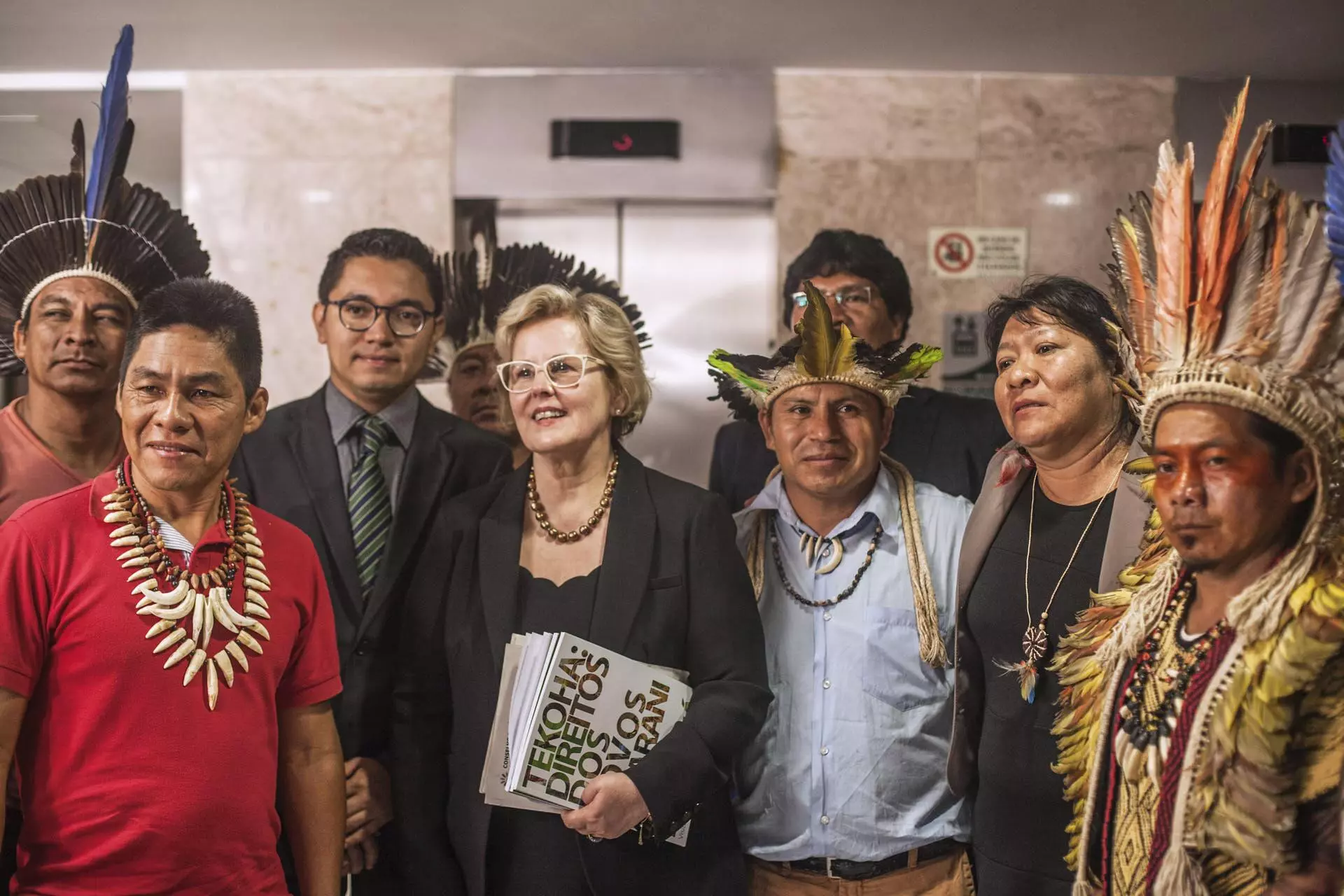
Indigenous leaders with Federal Supreme Court Justice Rosa Weber, at the Free Land Camp, in 2017. The Justice, who is now the president of the Federal Supreme Court, announced that the judgment of the time limit trick will be resumed in June 2023. Photo: Júlia Mente/National Indigenous Mobilization
The imminent resumption of the time limit trick judgment has generated a mixture of expectation and apprehension among indigenous peoples. According to two of the leaders of the Articulation of Indigenous Peoples of Brazil (Apib) consulted by SUMAÚMA – Mauricio Terena, indigenous lawyer and legal coordinator, and Dinaman Tuxá, executive coordinator, it is the “judgment of the century”.
“It is vitally important that this judgment takes place this year, so that once and for all we can put aside this theory that is so damaging to all indigenous peoples. We are talking about lands and territories that have belonged to these peoples for thousands of years, about the original peoples’ rights, which predate the formation of the Brazilian State,” said Dinaman.
“The time limit trick will not only affect Brazil’s indigenous peoples. Because, when we are talking about indigenous lands, we are talking about territories whose biodiversity has been much better preserved. This judgment has implications for the climate emergency,” stated Mauricio Terena.
If the Federal Supreme Court decides to recognize the time limit trick argument and demarcation ends up being negatively affected, it will cause an incalculable process of ethnocide. The reason for this is that when we talk about indigenous territories, we are talking about cultural identity, of peoples who need their territories to exercise their cultural rights, their habits and customs, protect their health. In addition to our territories being disputed, our very existence is also being contested,” added the indigenous lawyer.
At this year’s Free Land Camp, the indigenous peoples will also declare a state of “climate emergency” to condemn violations of rights resulting from climate change. According to Apib, a cross-check of data carried out in 2022, in partnership with the Amazon Environmental Research Institute (Ipam), has identified that 29% of the territory around indigenous lands in Brazil has been deforested. However, inside the territories, deforestation stands at a mere 2%. “There is no solution to the climate crisis without indigenous peoples and the full demarcation of our lands,” Dinaman asserted.
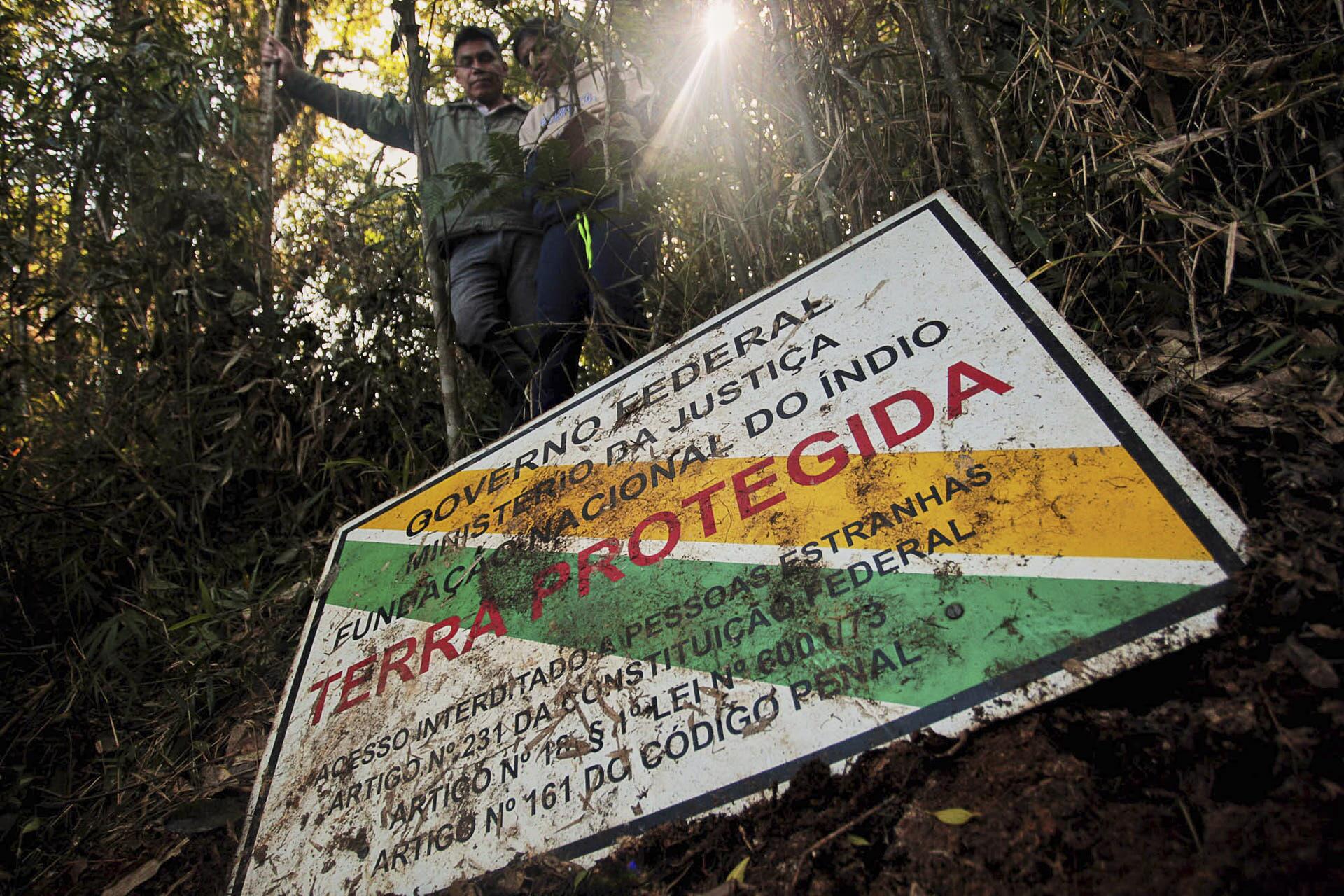
The Protected Land sign was torn down by invaders in the Ibirama-La Klãnõ Indigenous Land, in the Alto Vale do Itajaí region, in the State of Santa Catarina. The judgment in this case, which will be resumed in June, will have widespread repercussions on the debate over the time limit trick. Photo: Lucas Amarelli/Amazônia Real
Extermination practiced by “bugreiros” (hunters of indigenous people)
The case under analysis by the Federal Supreme Court discusses the extent of the Ibirama-La Klãnõ Indigenous Land, in the Alto Vale do Itajaí region, in the State of Santa Catarina, which is home to Guarani, Guarani Mbya, Guarani Ñandeva, Kaingang and Xokleng indigenous peoples. This debate reached the courts in 2009, when the Environmental Foundation (Fatma), now the Environmental Institute of the government of Santa Catarina (IMA), claimed that it was the true owner of eight hectares within the indigenous land of more than 37,000 hectares, and requested a repossession order for the area. The State of Santa Catarina’s government won the dispute in the district court and in the appeals court, and the case reached the Supreme Court after an appeal by the National Foundation of Indigenous Peoples (Funai). The rapporteur chosen to handle the case, Justice Edson Fachin, accepted Funai’s appeal and stated that it was necessary to define the “legal-constitutional status of the possession relations in areas of traditional indigenous occupation, under the terms of article 231 of the Constitution”.
The article mentioned by Justice Fachin reads as follows: “The social organization, customs, languages, beliefs and traditions of indigenous people are recognized, along with the original people’s rights over the lands they have traditionally occupied, and the Federal Government is responsible for demarcating them and protecting and enforcing compliance in relation to all of their assets”. The members of congress who were responsible for the new constitution went into more detail about what indigenous lands are in paragraph two (“the lands traditionally occupied by the indigenous people are to be held by them on a perpetual basis, and the exclusive usage of the riches of the soil, rivers and lakes existing therein shall belong to them”) and paragraph four (“the lands referred to in this article are inalienable and unavailable, and the rights over the aforesaid lands cannot be annulled”).
In other words, Justice Fachin said that the time had come for the Federal Supreme Court to decide whether or not the indigenous people’s right to their territories predated the Constitution of 1988 and or the formation of the country that would come to be known as Brazil. The judgment on the time limit trick has been one of the driving factors behind the indigenous struggle in recent years because it is not a question of an isolated case in the State of Santa Catarina. The Justices’ final vote will have widespread repercussions, in other words, it will affect the future of demarcations of all indigenous lands in Brazil, rather than merely determining what will happen in a fraction of the territory of the Xokleng people and their relatives in the State of Santa Catarina.
The Xokleng were almost exterminated, during the 20th century, by Italian settlers who received “uninhabited” land in the State of Santa Catarina from the Brazilian government. They were hunted by killers called “bugreiros,” who were hired by the settlers to go into the forest and hunt down and wipe out its original inhabitants. But the idea of a time limit trick predates the government of Santa Catarina legal battle against the Ibirama-La Klãnõ Indigenous Land.
The natural lords of the land
The idea that “the lands traditionally occupied by the indigenous people are reserved for their perpetual possession,” expressed in the Constitution, is based on a well-established legal argument, called the theory of indigenato. According to this, “the rights of indigenous peoples predate even the very conception of the idea of the National State,” explained Mauricio Terena. “This argument dates back to the colonial period, where the laws that were issued respected the possession of the original peoples as being the natural lords of their lands,” noted Eloy Terena, who is also an indigenous lawyer and currently the executive secretary of the Ministry of Indigenous Peoples, in a 2020 article.
However, there is another view that opposes the theory of original peoples’ rights. This other theory is known as the theory of indigenous fact, which supports the concept of the time limit trick – in other words, the idea that only those lands that were occupied by the original Brazilian peoples when the current Constitution came into force in 1988 can be regarded as indigenous lands.
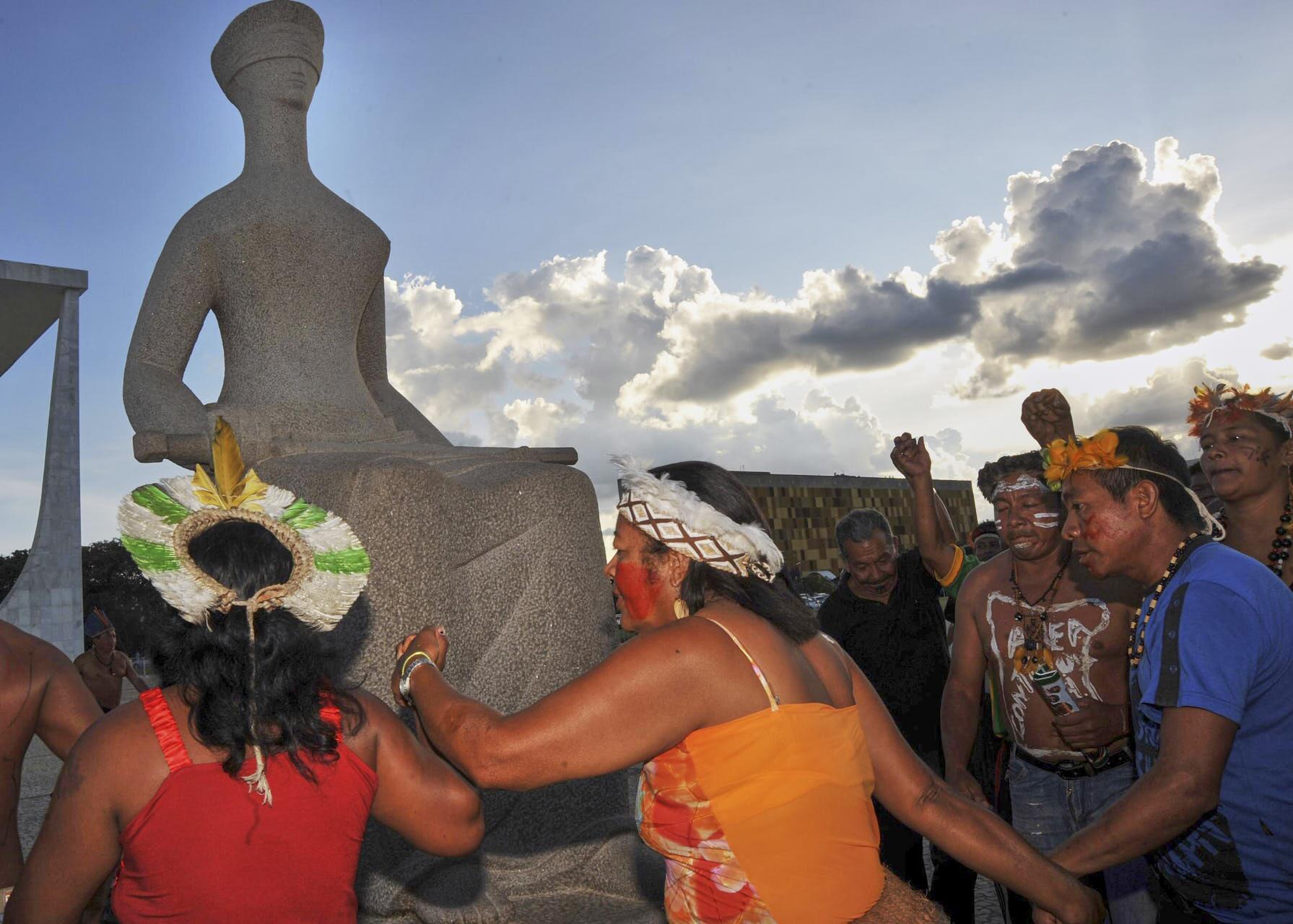
The struggle against the time limit trick has been going on for years among the indigenous movements: in 2009, indigenous people celebrated in the Three Powers Plaza the result of the judgment by the Federal Supreme Court that, by 10 votes to 1, decided to maintain the demarcation of the Raposa Serra do Sol Indigenous Land in the State of Roraima. Photo: José Cruz/Agência Brasil
The theory of the time limit trick became infamous in 2009, at the time the Federal Supreme Court was judging the demarcation of the Raposa Serra do Sol Indigenous Land, which was home to the Macuxi, Taurepang, Patamona, Ingaricó and Wapichana peoples in the State of Roraima. “The expression predates even the 1988 Constitution, but became popular during the Raposa Serra do Sol judgment,” explained Deborah Duprat, who at the time was in charge of the Federal Prosecution Service’s 6th Coordination and Review Chamber, responsible for defending the rights of indigenous peoples, the inhabitants of quilombos (settlements founded by people of African origin), extractivist communities, riverbank dwellers’ communities and gypsies. At the present time, Duprat is a lawyer.
“The first major judgment by the Federal Supreme Court after [the enactment of the 1988] Constitution is the Raposa Serra do Sol case. It already contained a number of elements that only intensified in the following period, such as the belief that it requires ‘people’ to occupy the Amazon region, in other words, that it does not consider the indigenous people as being capable of defending those borders. [There was] a very strong military presence, so to speak, in the Federal Supreme Court, in the sense of being cautious in relation to the demarcation of indigenous lands in the Amazon region. It was a judgment that ended up significantly hampering the indigenous issue, even though it was extremely favorable regarding the Raposa Serra do Sol indigenous land,” she remembered.
The rapporteur of the Raposa Serra do Sol case in the Federal Supreme Court, was the then-Justice Carlos Ayres Britto, who voted in favor of the continuous demarcation of the indigenous land and in favor of the removal of non-indigenous people from that territory. But he went further than that: he also listed a series of conditions, which did not apply to that case, but which would apply to other demarcations in the future, among them the idea that it was necessary to establish a time limit trick for them, under the argument that this was one of the intentions of the authors of the Constitution.
The lawyer Carolina Santana, who works for the Observatory of Indigenous Peoples and who a few weeks ago had her PhD thesis, which deals precisely with this issue, approved by the University of Brasília (UnB), told SUMAÚMA that “in his vote Ayres Britto said that the time limit trick was a constitutional intention, in other words, that this was discussed by those who drafted the Constitution during the National Constituent Assembly [of 1987]”.
“I decided to read the records [of the Constituent Assembly]. I read all of the discussions [regarding the wording of article 231]. The first thing I noticed is that, according to the official documents, this [the time limit trick] was not discussed,” Carolina explained. “In other words, [to now argue in favor of the time limit trick] is an absurd rewriting of the constitutional text, a kind of a veiled gentlemen’s agreement, a lie that has been repeated many times so that it has now taken on the appearance of something that is true, but that doesn’t stand up under scrutiny.”
Carolina Santana, like Deborah Duprat, Mauricio Terena and Eloy Terena, is part of the group of 51 indigenous and non-indigenous lawyers acting in defense of the original peoples in the time limit trick judgment at the Federal Supreme Court.
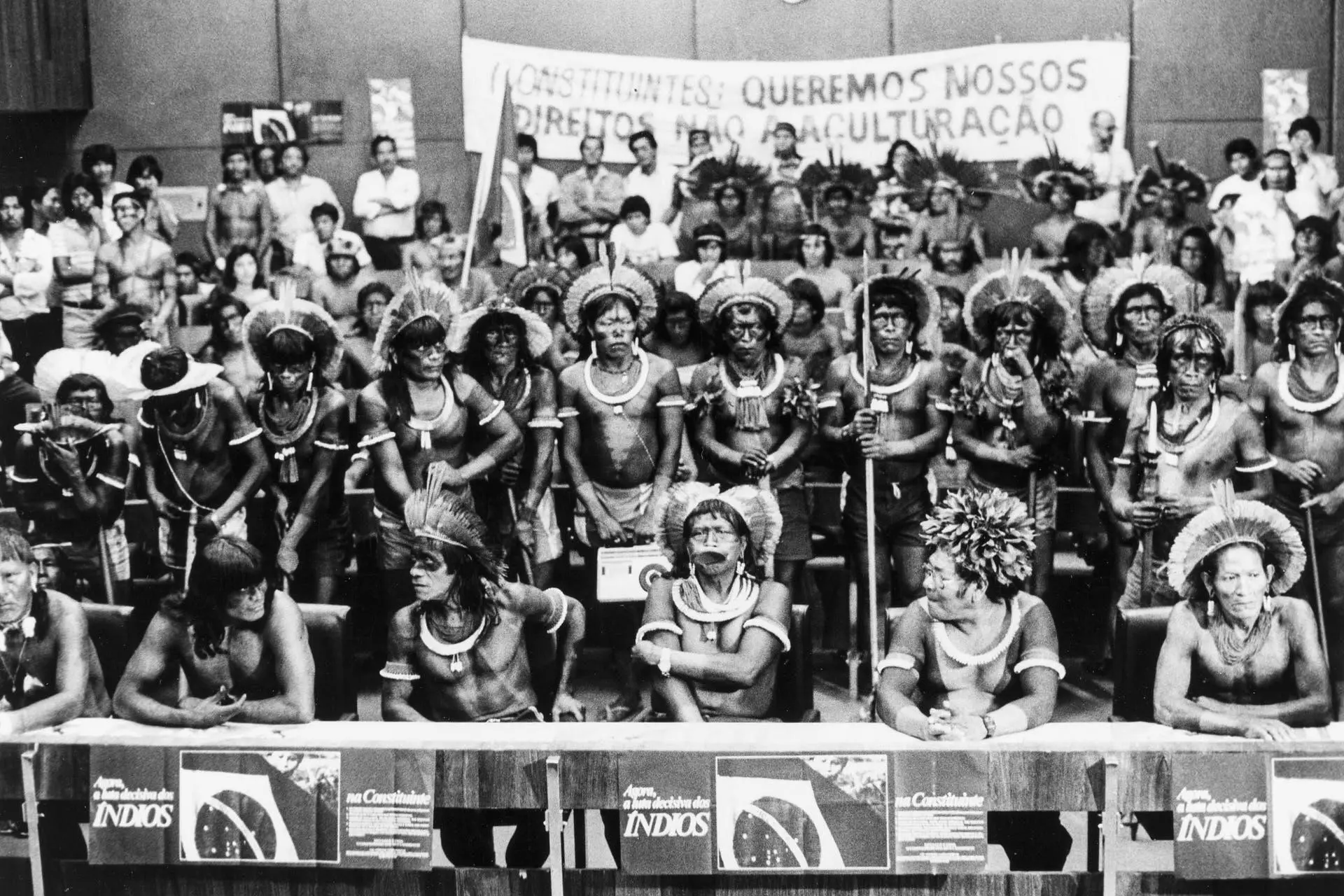
Representatives of a number of Indigenous Peoples during the negotiations of the National Constituent Assembly, on May 31, 1988. Photo: Beto Ricardo/ISA
“The Constitution has a protective purpose, to protect the indigenous peoples. A rule is never literal, it can be interpreted, but never to reach a conclusion that means a lack of protection, when the norm speaks of protection. This is what the time limit trick does,” argued Carolina.
In the research for her PhD thesis, the lawyer identifies an attempt to rewrite history from the point of view of those who are opposed to the demarcation of indigenous lands.
The idea that bodies such as the National Foundation of Indigenous Peoples (Funai) are “biased” when it comes to dealing with issues linked to indigenous peoples is also part of this narrative to undermine indigenous people’s rights. This argument is used in the direct action for the declaration of unconstitutionality in which the Progressives Party (PP), which supported Jair Bolsonaro’s re-election, has asked the Federal Supreme Court to take the prerogative for demarcating indigenous lands away from the Ministry of Indigenous Peoples, on the grounds that it is not “impartial” in relation to this matter. The lawsuit was filed just a few days before the start of the Free Land Camp (ATL), which does not appear to be just a coincidence, given that it is the federal government’s intention to announce new demarcations at this event in the city of Brasilia. The same list of arguments includes the theory of the “internationalization of the Amazon” based on the activities of non-governmental organizations (NGOs).
In 2008, Army General Augusto Heleno, who at the time was the military commander of the Amazon region, said to retired colleagues at the Military Club: “More and more we are increasing the extent of indigenous lands in the frontier regions and moving in a direction that worries me. They could represent a risk to national sovereignty”. He was referring to the demarcation of Raposa Serra do Sol. Heleno and a number of his colleagues never concealed their fear – which never had any real basis – that the indigenous peoples in the Amazon regions would declare their territories independent from Brazil.
Back to 1934?
Deborah Duprat, who worked at the start of the judgment, in 2019, said that at present she sees a more favorable outlook for indigenous peoples’ rights. “I think that the atmosphere that was predominant in the Federal Supreme Court at the time of the Raposa Serra do Sol judgment has changed for the better, you know? Because the [anti-democratic coup attempt of] January 8 happened. And, that as a result, the military force that was there at the Raposa Serra do Sol trial has somehow faded, or at least doesn’t have the same power that it had at the time of that judgment.
However, she admitted feeling distress at the delay. “There was a better moment for the judgment, at the end of the Bolsonaro government, with all the barbarism registered in indigenous lands. It was a moment when there was a reaction from the media, from society, from certain institutional sectors. I don’t know if the dismay among those in the Supreme Court that existed at a certain moment [has been maintained]. We need to keep it short, we need this judgment to be resumed, because over time things there lose their way to a very marked degree,” she warned.
Justice Ricardo Lewandowski’s retirement on April 11 has increased the concern among the lawyers who are defending the indigenous peoples in this case. That he would vote against the time limit trick was taken for granted. There is also fear that the Court may decide to make a compromise in relation to the interests of indigenous peoples vis-à-vis those of the agribusiness sector and those in the far right – who are stronger than they have ever been in the National Congress. For example, there is some speculation, that a decision could be taken that establishes a time limit trick, but in relation to 1934. This is not some random date. The briefest of the Brazilian constitutions, which was laid to rest in 1937 by the Estado Novo dictatorship, the 1934 charter was the first one to recognize the rights of Brazil’s indigenous populations.
“Any whatsoever time limit trick is bad, because it means that the indigenous people have to prove, by means of a procedural request, a journalistic article or any other record, that they fought to stay on the land from which they were expelled,” explained Carolina Santana. “Except that the indigenous peoples were wards of the state [in 1934], so it would be impossible for you to find a process in which they took legal action claiming the lands. And the practice of expelling indigenous people from their lands was so common that it didn’t even make the news. It is incredibly difficult to prove that they were evicted from their lands because one of our society’s characteristics is that it did not produce information about people whose lives had no value”.
Deborah Duprat agrees: “To establish any whatsoever time limit trick now, even if it does not do any harm, will be felt as a defeat.”
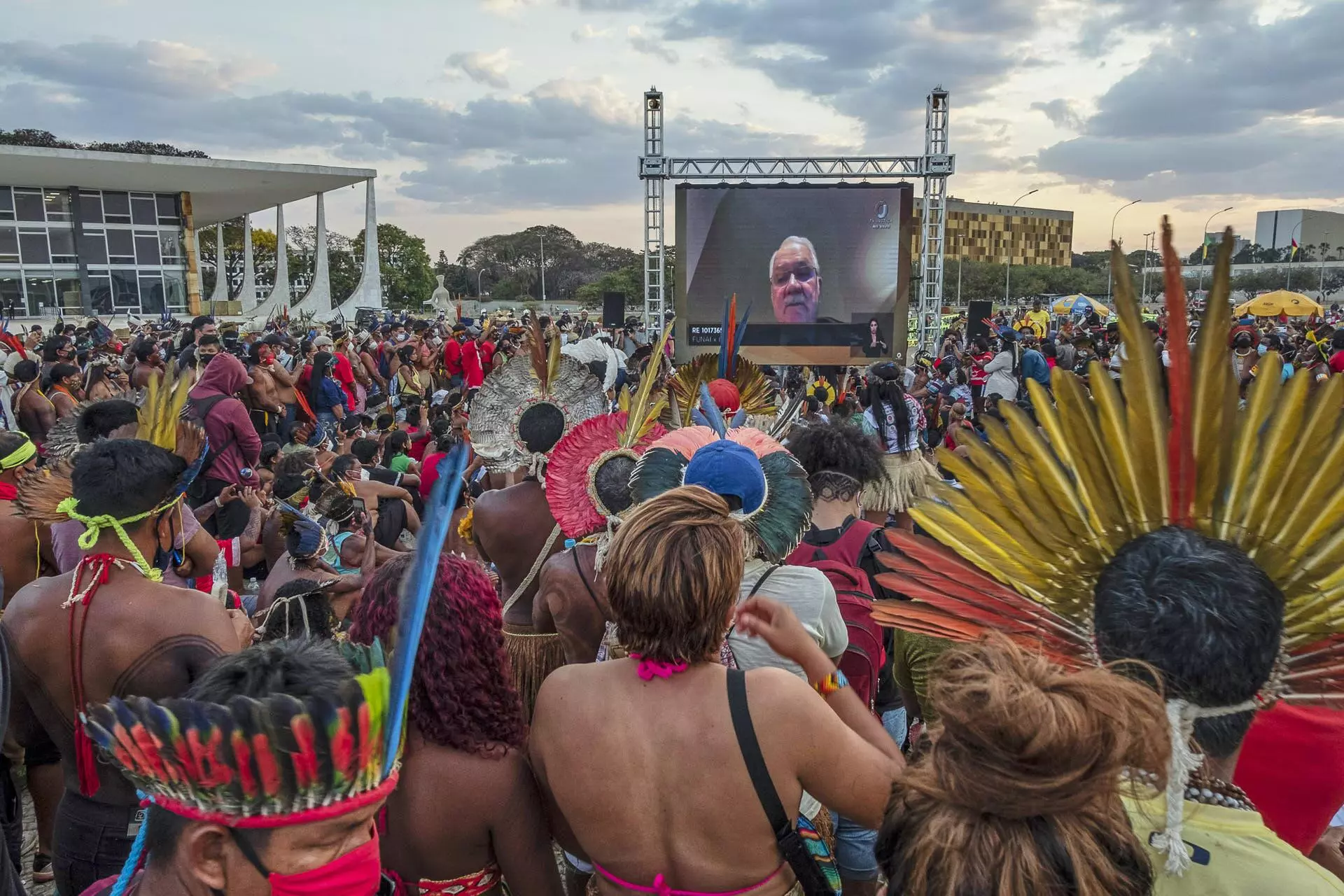
Indigenous peoples’ vigil in the Three Powers Plaza, in Brasília, to accompany the judgment regarding the time limit trick in the Federal Supreme Court, in August 2021. On the screen, Justice Edson Fachin, who voted against the thesis of the time limit trick. Photo: Leonardo Milano/Amazônia Real
For now, the trial has one vote against the time limit trick, that of the rapporteur, Justice Edson Fachin, and one in favor, that of Justice Nunes Marques. The next one who is scheduled to vote is Justice Alexandre de Moraes, who in September 2021 asked to see the case records. The great expectation, among lawyers who are defending the indigenous peoples, is for his vote. Moraes’ position is unknown. “He is a Justice who causes both positive and negative surprises on various fronts,” summed up one of them, who spoke under the condition that he not be identified. The votes of the Justices Gilmar Mendes and Carmen Lúcia are also in doubt. Indigenous leaders and lawyers regard it as likely that Rosa Weber, Luís Roberto Barroso and Luiz Fux will vote against the time limit trick. On the other side there would be Justices André Mendonça, who was appointed by Bolsonaro, and Dias Toffoli.
“With the time limit trick, extinction will be total”
Amidst the anticipation regarding for the Free Land Camp (ATL) and the resumption of the judgment by the Federal Supreme Court, the country’s first indigenous lawyer, Joenia Wapichana, who acted in the Raposa Serra do Sol case and is currently the president of the National Foundation of Indigenous Peoples (Funai), a few days ago inaugurated an exhibition of 15 large photographs that the photographer Sebastião Salgado took in 2017 of members of the indigenous Korubo people, a people with whom contact who had only recently been made, and who live in the Javari Valley, in the State of Amazonas. Donated by the artist to the National Foundation of Indigenous Peoples, they were rejected by the Bolsonaro government after Salgado criticized the far-right president in 2020 – at the time, it was up to the Federal Public Prosecutor’s Office to intercede and provide proper safekeeping for the pieces in question.
Present at the ceremony to reinclude the pieces in the National Foundation of Indigenous Peoples’ (Funai’s) collection, Salgado spoke to SUMAÚMA about the judgment by the Federal Supreme Court. “The time limit trick is a threat, an attempt to steal indigenous lands. There has to be a defense of that territory, which is protected by the Constitution.”
“My people have already been almost wiped out once,” Ana Patté Xokleng, one of the leaders of her people, who currently works at the Ministry of Indigenous Peoples as an advisor on congressional matters, told SUMAÚMA. Ana Patté knows that, if the Federal Supreme Court decides that the time limit trick should come into effect, it will not be just her people who will have yet another piece of their already diminished territory stolen from them, once again. “My people have already been almost wiped out once. If the time limit trick is approved, what you will have is total extinction. And perhaps of all indigenous peoples,” she predicted.
“When you demarcate an indigenous territory, it is an opportunity to have water to drink. When you demarcate an indigenous territory, it is also an opportunity to have air to breathe. We are lung specialists. We support the lungs of the world and of the people,” said the indigenous federal deputy Célia Xakriabá (Socialism and Liberty Party, for the State of Minas Gerais) in an exclusive interview with SUMAÚMA. Going against the guardians of the forest that still remains standing is a risk that Brazil, which entered 2023 posting new records in terms of deforestation, cannot take.
Spell check (Portuguese): Elvira Gago
Translation into Spanish: Meritxell Almarza
English translation: Mark Murray
Photography editing: Marcelo Aguilar, Mariana Greif and Pablo Albarenga
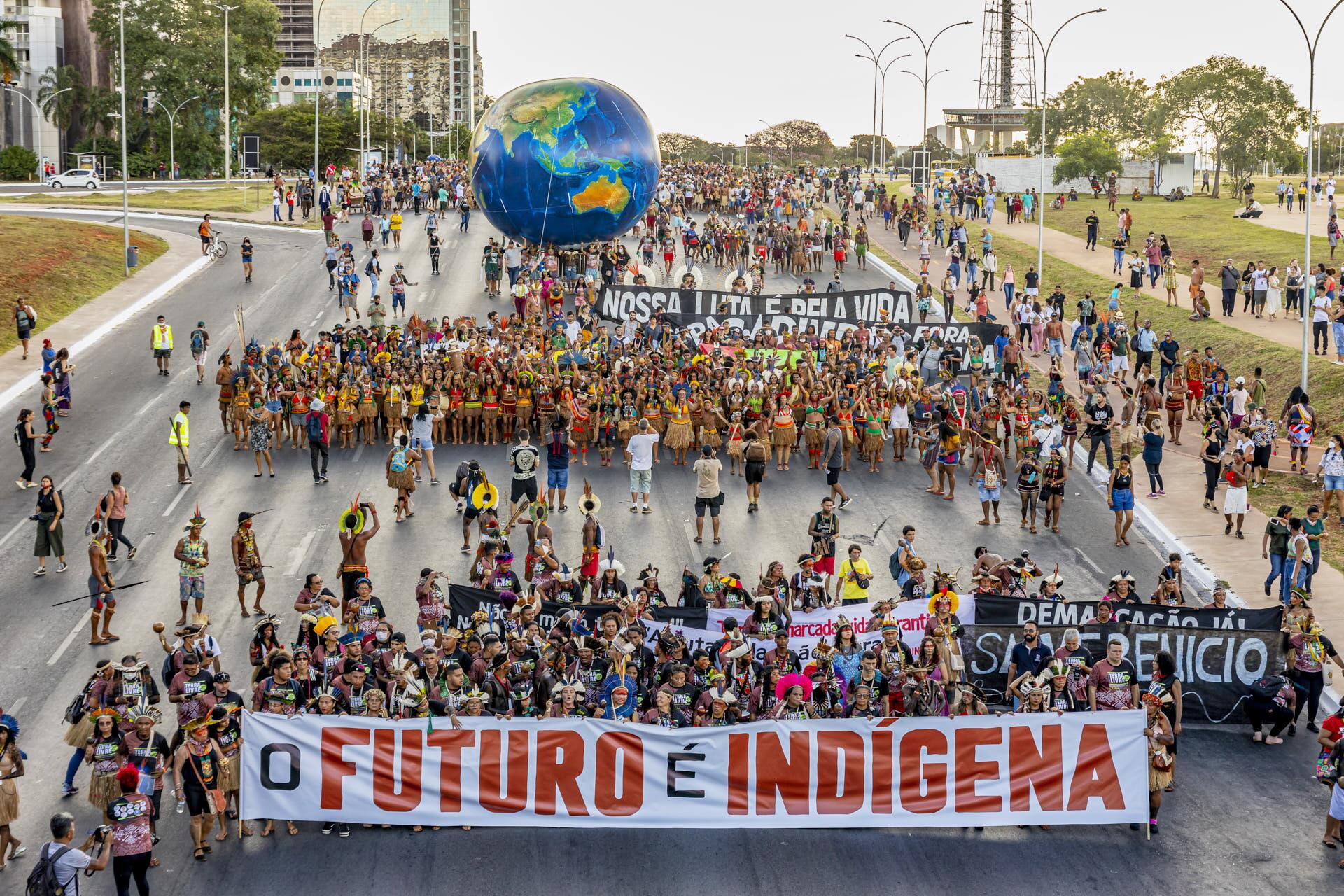
March by indigenous movements in the Free Land Camp, in 2022, at the Esplanade of Ministries, in Brasília. Photo: Mídia Ninja





